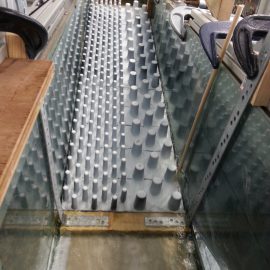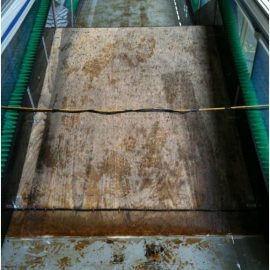Gauging weirs are common in modified rivers and essential for management practices. High water velocities and levels of turbulence created on the downstream weir face and location of the hydraulic jump, respectively, are common hydraulic features associated with gauging structures. These conditions are often difficult, particularly for diadromous anguilliform species such as eel (Anguilla spp.) and lamprey (Petromyzon spp. and Lampetra spp.), to ascend. Poor passage is often a reflection of their low swimming capabilities and distinct body morphologies and behaviour in comparison to subcaragiform species (such as salmon). Unique behavioural strategies adopted by anguilliform fish during upstream migration (such as climbing) provide an opportunity for the development of novel, species-specific solutions. For eel, synthetic bristle board passes have been developed and widely implemented. More recently, these have been installed oriented vertically and attached to the side of gauging structures. Similarly, tiles consisting of a staggered array of plastic studs have also been installed on low-head weirs in both vertical and horizontal configurations.
Research at ICER has provided a better understanding of the behaviour and passage performance of anguilliform species as they attempt to ascend gauging weirs. And, despite implementation in the field, ICER has provided the first robust studies quantifying the ability of both European eel (Anguilla anguilla) and river lamprey (Lampetra fluviatilis) to ascend gauging weirs using bristle passes and studded tiles. Results from a series of open channel flume studies demonstrate that gauging weirs can limit and prevent the upstream movement of eel and lamprey. However, despite inter-specific differences and some difficulty manoeuvring through bristles/studs, these species-specific solutions improved upstream passage for both species. This research was funded by the Environment Agency (England).
Media:
Publications:
Russon, I.J., Kemp, P.S. & Lucas, M.C. (2011). Gauging weirs impede the upstream migration of adult river lamprey Lampetra fluviatilis. Fisheries Management and Ecology 18: 201-210.
Kerr, J.R., Karageorgopoulos, P. & Kemp, P. S. (2015). Efficacy of a side-mounted vertically oriented bristle pass for improving upstream passage of European eel (Anguilla anguilla) and river lamprey (Lampetra fluviatilis) at an experimental Crump weir. Ecological Engineering 85: 121-131.
Vowles, A.S., Don, A.M., Karageoropoulos, P., Worthington, T.A. and Kemp, P.S. (2015). Efficiency of a dual density studded fish pass designed to mitigate for impeded upstream passage of juvenile European eels (Anguilla anguilla) at a model Crump weir. Fisheries Management and Ecology 22: 307-316.
Vowles, A.S., Don, A.M., Karageorgopoulos, P. & Kemp, P.S. (2017). Passage of European eel and river lamprey at a model weir provisioned with studded tiles. Journal of Ecohydraulics 2: 88-98.
People:
Dr Jim Kerr
Dr Iain Russon
Dr Andrew Vowles
Prof Paul Kemp


